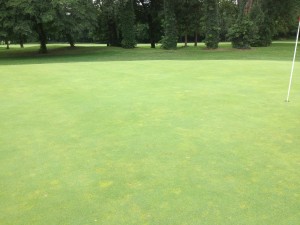(By Jared Hoyle, KSU Turfgrass Research and Extension)

Golf course superintendents in KS typically have to manage annual bluegrass in putting greens and not so much “control” it because of the large populations of annual bluegrass that exist in the putting greens.
One of annual bluegrass management practices is the use of PGRs. This is combination with aerification, pre-emergent herbicides, fertility and proper irrigation management, just to mention a few, can lead to the success of reducing annual bluegrass populations and increasing bentgrass incidence.
Timing of the PGR applications in the spring can be one of the most difficult tasks. Too late can lead to a summer of playing catch-up. The use of Growing Degree Days (GDD) can really help predict PGR application timings.
Just type in your location on the “Proxy/Primo Seedhead Timer (GDD 32)” page and it will give you the GDD in your area. Earlier applications have seen to be more effective than later applications so try and get a Proxy/Primo application out after two mowings (full green-up) or 200-250 growing degree-days on the GDD 32 model. The Target Range is 200-500 but greater success has been seen when the initial application was made earlier. In 2014 Manhattan, KS reached 200 GDD (base 32) on March 15th. Right now Manhattan is at 5 GDD. But watch out it can catch-up real quick!
Research conducted out of MSU suggests that tank mixes of Proxy/Primo for Poa annua Seedhead Suppression on bentgrass greens should be made at 5 + 0.125 fl oz per 1000ft2. A repeat application can be made 21 days later. If golf course superintendents plan on applying Primo throughout the season then they can start their program 14-21 days after the tankmix treatment.
Information contained in this blog can be found at http://www.gddtracker.net/about ; Dept. of Crop and Soil Sciences, Michigan State University.
Always remember to READ THE LABEL for the correct rate, turfgrass tolerance, and specific instructions before application!!!
***Mention of trade names or commercial products in this article is solely for identification purposes and does not imply recommendation or endorsement, nor is criticism implied of similar products not mentioned by Kansas State University.***
Don’t forget to follow me on twitter @KSUTurf.
Also, visit our facebook page www.facebook.com/KSUTurf
